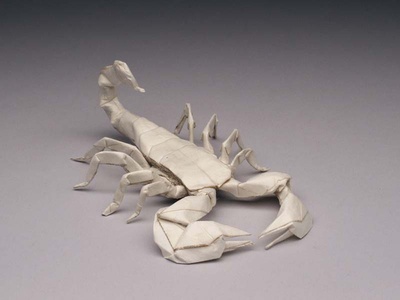“When I was a child growing up in Scotland, I was first introduced to origami by two Japanese students of my father’s who gave me a little origami doll,” Meher McArthur recalls. “The doll was very delicate and I had no idea how it was made. Later my parents bought me a book by Robert Harbin, a British magician who taught origami, and I caught the bug.”
“I lost interest as I grew up, and was only able to fold a few forms as a party trick every now and again,” says McArthur. “However, I did develop an interest in Japanese culture—perhaps because of my childhood paper doll—and chose to study Japanese at college. In the course of my studies I fell in love with Japanese culture and art in particular, and went on to study Japanese art history.”
One of the stories McArthur learned about was that of Sadako Sasaki, a Japanese girl who became terminally ill as a result of radiation exposure from the World War II atomic bombing of Hiroshima. Sadako became famous for her determination to fold a thousand paper cranes, which according to Japanese legend grants the folder one special wish. Following Sadako’s death, the origami crane became an international symbol for peace and hope.
“In my late 20s, when my mother was ill with leukemia, I folded a garland of cranes for her in the hope that she would recover, just as Sadako did,” McArthur explains. “But alas, my wish was not granted either. Shortly afterwards, I started curating exhibitions of Japanese and other Asian art, but had not considered an exhibition of origami until I saw Vanessa Gould’s superb documentary, Between the Folds . I realized that this was an area of Japanese art—just like woodblock prints 100 years ago—that was not being taken seriously enough by the art world and that I could help origami artists gain the recognition they deserve.”
So began McArthur’s inspiration for the Japanese American National Museum’s new exhibition, Folding Paper: The Infinite Possibilities of Origami .
“The most important message that the exhibition shares is that origami is no longer just a craft for kids,” says McArthur. “It has evolved into a sophisticated art form now, with many artists all over the world using the medium of folded paper to express themselves.”

Robert J. Lang. "Emperor Scorpion HP, opus 593," 2011. One uncut square of Korean hanji paper. Photo © Robert J. Lang.
“Between the Folds introduced the work of some of the most outstanding contemporary artists and shows how art and science intersect in many of their works,” McArthur says. “I realized then that origami has transformed into something very exciting and that this transformation should be illustrated in a museum exhibition that will be seen by as many people as possible.”
“I spoke to renowned origami artist and physicist Robert J. Lang and asked if he thought I should curate an exhibition,” says McArthur. “He was very enthusiastic and has helped me greatly over the two years of the exhibition’s development. I then approached the Japanese American National Museum and received a very enthusiastic response about the idea of having such an exhibition there. My next step was to work with a traveling exhibition company to develop the exhibition and make sure there was enough interest nationally in a touring origami exhibition. I have been working closely with the team at International Arts & Artists (a traveling exhibitions company based in Washington, D.C.) to curate the exhibition, communicate with artists around the world, fundraise, market the exhibition to museums, write the exhibition catalog.”

Eric Joisel, "Mask, 1999." Paper, folded wet and coated, on wire. Photo © Mingei International Museum, Gift of V'Ann Cornelius.
“It has been a very complex exhibition to coordinate, in part because of the number of artists involved (about 45), the number of countries involved (about 15), and the issues involving packing and shipping origami art works for tour—a first, I’m sure,” says McArthur. “Some of the original artists I had planned to have in the exhibition were unable to participate, but along the way I discovered the works of others who are quite extraordinary. It’s been fascinating to realize how much origami art is being created in different parts of the world by very diverse people.”
McArthur’s journey on the project led to both challenges and surprises. “I wanted to tell as much of the story of the evolution of origami as possible through the exhibition and accompanying catalog, so I had to research the subject as best I could despite the lack of documentation. One of the biggest surprises for me was learning about the European and even South American traditions of paper folding, about which I had known nothing prior to this project.”
Initial responses to the project have been enthusiastic.
“I have been curating exhibitions for 15 years now and this is the one that had the most positive reaction from people I talk to about it—both kids and adults,” McArthur says. “As I have been preparing this exhibition and telling people about it, I have had a fairly universal reaction from people. ‘How cool! I had no idea origami was so amazing!’ Men, women, children, Japanese, Japanese American, and people from other cultural backgrounds all seem excited by the idea of this exhibition. I think it’s because everyone knows about origami—it’s something familiar—yet, the exhibition is showing a new side to it.”
“The exhibition is made up of my favorite pieces that the various incredible artists have created,” McArthur says. “I feel very emotional about the pieces in the exhibition that relate to wishes for peace—for example the tiny crane that was folded by Sadako 50 years ago and the amazing work of Miri Golan, Two Books , which illustrates her wish for peace in Israel. But I really love all the pieces in the exhibition. They are all amazing for different reasons.”

Miri Golan, "Two Books," 2010. Paper and handmade books. Photo © Leonid Padrul- Kwitkowski/Eretz Israel Museum.
Some of these reasons, McArthur explains, also point to origami’s underappreciated relevance to other subjects. “In the context of a museum, we look at origami as an art form, but it is also important to remember that there is a lot of mathematics involved in the elaborate folding of many of these pieces. Origami is both an art and a science. It is also having a profound impact on science. Both artists and scientists are using origami folding techniques in space exploration, engineering and molecular biology. It’s also influencing fashion, architecture and design.”
“Origami is all around us!” says McArthur. “And that’s why I think its possibilities are truly infinite.”
* * *
Folding Paper: The Infinite Possibilities of Origami
March 10 through August 26, 2012
Japanese American National Museum
Los Angeles, California
The first major exhibition to explore the international phenomenon of origami as a contemporary visual art form and illustrate the influence of origami on technology, math, science, art, design, and the global peace movement. Featuring over 150 works by more than 40 artists from 16 countries.
More information: http://www.janm.org/exhibits/foldingpaper/
© 2012 Japanese American National Museum






